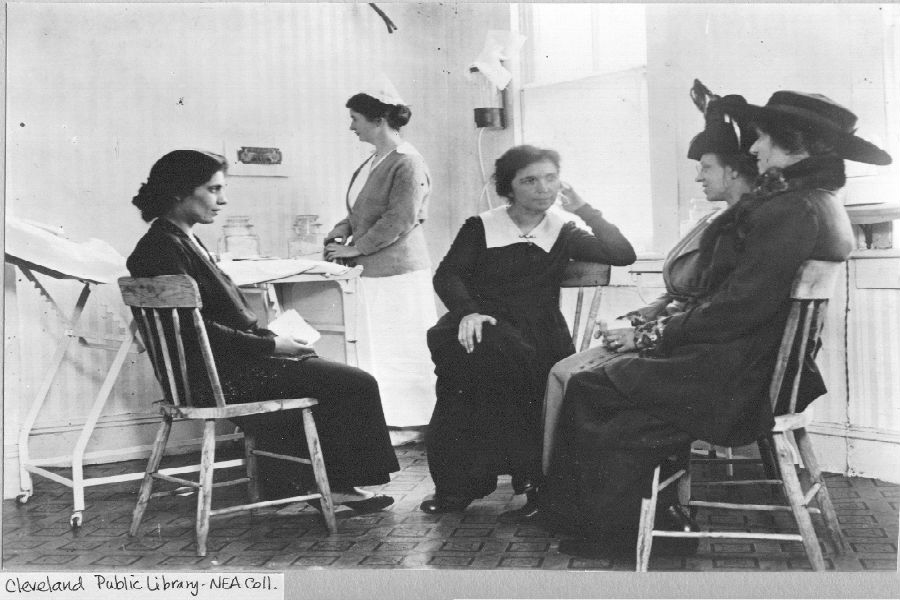Woman of the Month: The Woman who Planned for Parenthood
https://images.app.goo.gl/iZiYYPWv5NkTfLxw6
Sanger with her sister Ethel inside their clinic on Amboy Street in Brooklyn, New York
February 1, 2020
During a time when women continued to endeavor to hold control over their positions in society, Margaret Sanger changed the world through her advocation for women’s rights to control their bodies.
Sanger was born on September 14, 1879, in Corning, NY, to Michael and Anne Higgins. The sixth of eleven children, Sanger blamed her mother for the financial burden caused by the many children.
In 1896, Sanger began attending Claverack College, a co-ed prep school in New York. She loved life at Claverack, but, when Anne began dying of tuberculosis, Sanger returned to take care of her.
Soon, life with her overbearing father became intolerable. To get out from under his thumb, Sanger attended nursing school in New York. Upon finishing her studies at White Plains Hospital, Sanger was offered the chance to participate in a three-year degree program. Instead of accepting the program, Sanger married artist and architect William Sanger.
Following the birth of her daughter Peggy, in 1910, Sanger, unhappy with the housewife’s life, moved her family to Manhattan. For two years, she worked as an obstetric nurse in the Lower Eastside. While in Manhattan, Sanger found herself intrigued by the radical labor movement. Joining the International Workers of the World, she met anarchist Emma Goldman and quickly found her belief in the connection between economic and feminist issues, bolstered by Goldman’s influence.
Inspired by her belief that her family’s economic hardships were caused by her mother’s inability to prevent conception, Sanger became an advocate for sex reforms, preaching the necessity for “information about birth control, sex education, and venereal disease” (“Margaret Sanger”).
But, her quest was hindered by the Comstock Law, a law passed in 1873 that “ made it a criminal offense to import, mail, or transport in interstate commerce ‘any obscene book, pamphlet . . . instrument . . . or any drug or medicine, or any article whatever, for the prevention of conception, or for causing unlawful abortion.’” (“Margaret Sanger”).
When Sadie Sachs, a patient of Sanger, died due to an illegal abortion, Sanger became adamant that women needed to be provided with information about and the ability to obtain contraception. In March 1914, she founded The Woman Rebel, coining the term “birth control” and introducing her “militant advocacy” of it. Five months later, Sanger was arrested for violating the Comstock Law but fled to England after jumping bail (“The First Birth Control Clinics in America and England”). While she was living in England, Sanger’s daughter died of pneumonia. Peggy’s death produced an outpour of public sympathy, prompting the charges against Sanger to be dropped, and allowing her to return to America.
On October 16, 1916, Sanger and her sister, Ethel Byrne opened the first birth control clinic in America, in Brownsville, NY (“Birth Control”). While the clinic was open, they supplied almost 500 women with devices, counseling, and information regarding birth control. After only ten days operating, the clinic was shut down by the police, and Byrne and Sanger were arrested for and convicted of disturbing the peace.
The trial against the women brought national attention to the birth control issue. When a verdict on the case was reached, the result gave medical providers the ability to provide information to women about disease prevention.
In 1921, with the help of “financial angels”, Sanger established the American Birth Control League (ABCL) (“Birth Control”), an organization that in twenty years, would combine with the Birth Control Clinical Research Bureau (BCCRB) under the new name: Planned Parenthood Federation of America.
Continuing to push for clinics staffed by medical professionals, in 1923, Sanger organized the Birth Control Clinical Research Bureau, the first birth control clinic staffed by medical practitioners. Headed by Dr. Hannah Stone, the BCCRB provided detailed information about birth control and served as a teaching center for doctors about contraceptive methods. By 1938, over 300 similar clinics had been set up by Sanger and her patrons.
In 1936, the ruling in U.S. vs. One Package, a case regarding Dr. Stone’s decision to purchase and ship diagrams from Japan (“United States v. One Package”), produced a revision to the Comstock Law, allowing medical care providers to receive contraceptives. One year later, the American Medical Association legitimized birth control.
Sanger’s ambitions extended beyond the 1937 legalization of birth control. Searching for a method of birth control that could be easily taken, Planned Parenthood supplied biologist Gregory Pincus with money to formulate ‘the pill’. “Between 1953 and 1956 Pincus, Min Chueh Chang, and John Rock published scientific results that eventually led to the commercial production of the birth control pill.” (“The First Birth Control Clinics in America and England”). By the 1960s, the invention of ‘the pill’ connected birth control to women’s rights, providing women with the ability to focus on life outside of the home.
Sanger was a strong, perseverant woman opinionated who fought until the end for what she believed. While her eugenic background could negate the good intentions behind her push for birth control, the benefits of her actions are not as easily invalidated. Whether it be for contraceptive purposes or for medical reasons, women across America utilize Sanger’s Planned Parenthood, and the medical services it provides to aid in their everyday lives. From the avoidance or treatment of STIs to the reduction of risks associated with unsafe pregnancies, information, that could be used by women to improve their way of life, was labeled as obscene by our government. But, Sanger fought to destigmatize and remove the negativity connoted by the female anatomy. She was never afraid to put herself at risk for the benefit of others. The courage she exhibited by continually disobeying the law in spite of the dangers threatened by her opposers through legal recourse or physical attacks, demonstrates drive and passion that is worthy of our respect.
Furthermore, Sanger’s rise from poverty to an influential woman with the means to establish institutions such as the first birth control clinic or Planned Parenthood conveyed to women of her time that their lives could be improved upon through hard work and determination, a message that is still heard by women of today. Through a speech given by Sanger to a group of women, she discusses the concept of a woman’s duty and demonstrates her support of the gospel of wealth. She shows the women a “child-mother”, explaining how the mother’s obligation to work and make a living has resulted in the birth of a malformed, undernourished, sickly child. She beseeches the women to “arouse [themselves]” because if “[they] are not so unfortunately placed, it is but a trick of circumstances” – Margaret Sanger (“To Mothers – Our Duty”). As a woman who experienced both poverty and comfort within her lifetime, Sanger comprehended the thinness of the line between destitution and prosperity, a fact that helped her appeal to women of every social class. With her knowledge as a mother who was able to provide for her children and as a child who was barely provided for, Sanger understood how detrimental the birth of a child, sickly or not, to a family unable to provide, could be for the mother and the child.
As a young woman hoping to have children in the future, the idea that someone was looking out for the futures of my children and me before I was born, is a comfort that I can attribute to Margaret Sanger. As a teenager, I am like the “child-mother”, unable to provide my child with the love and time it deserves. Perhaps, similarly to the mother, I would simply require the support of my fellow women to provide for my child, but the necessary sacrifices required for such a task, can today, be prevented through contraceptives provided legally to anyone in America, thanks to Margaret Sanger.









Anh • Feb 3, 2020 at 5:59 am
What a great article this month. She may have been one of the first women to look at health disparities in our country. This issue of health inequality still exists so thank you for shedding light on this ongoing issue under a different lens.
Candace Valente • Feb 1, 2020 at 2:16 pm
Athen!!!!
Bravo!!
I am a friend of your mom and I’ve been a nurse in women’s health most of my adult life and I never knew this powerful history! What an amazing woman she was. My mother was born in 1928 and this is what she and my grandmother had to deal with. And now people are trying to move women backwards!! This is such a powerful article and I’m hoping for you to have it published where it can be read to every young girl in the world!! Thank you so much for writing such an impactful article!!
Ou are incredible and strong and you will be stronger every day!
Kindly,
Candace